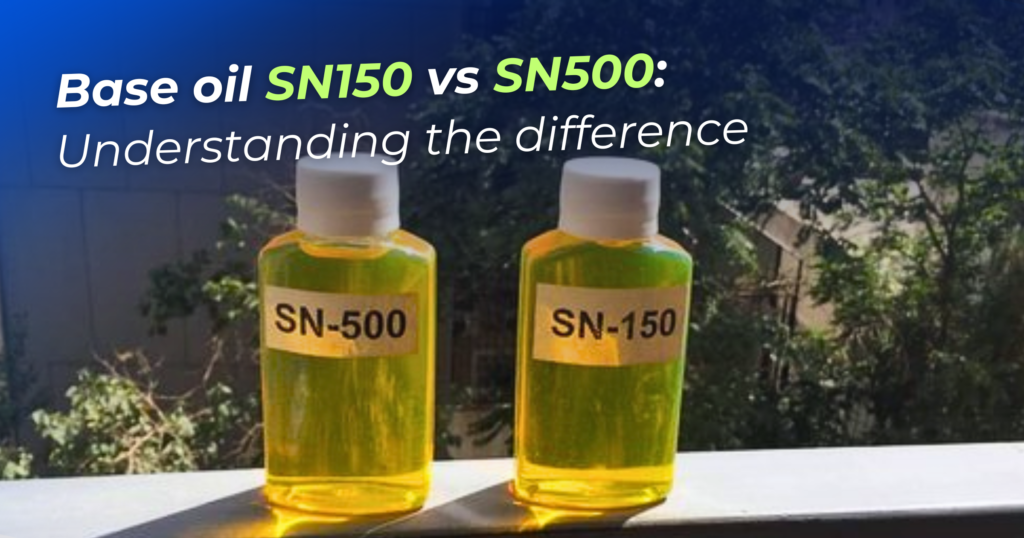
Base oil SN150 vs SN500. In every epic tale, some characters might not always be front and center, but their roles are pivotal. Think of the unsung heroes in your favorite sports teams or movies. They might not always get the spotlight, but their contributions are undeniable. In the vast, intricate narrative of the industrial world, base oils play such a role. They might not be the stars of the show, but their impact is monumental.
Imagine a world where Vehicles, trains, and power stations grind to a halt, and the many devices we take for granted every day just… stop.
A grim picture, isn’t it?
That’s a world without base oils.
These oils are the lifeblood of countless industrial processes, ensuring everything runs like a dream. They’re the secret sauce, the magic ingredient that ensures everything from your car’s engine to the giant factory machinery operates without a hitch.
But what exactly are base oils? And why are they so crucial?
This article delves deeper into two variants- SN150 and SN500. Get ready to uncover the mysteries of these essential oils and discover why they’re the silent MVPs of the industrial world.
BASE OIL SN150 in Nigeria
What is SN150?
SN150 is a Group I base oil derived primarily from crude oil through a series of refining processes. Group I base oils, including SN150, are characterized by their solvent refining method, distinguishing them from other groups.
Firstly, viscosity is one of its defining features, typically between 135 to 165 cSt at 40°C, making it suitable for various applications. Also, it exhibits excellent thermal ability, crucial in engine oils, where oil is subjected to the intense heat of combustion. Furthermore, thanks to its high saturate and paraffinic content, SN150 is oxidation resistant, ensuring a longer oil life and reduced engine deposits.
Containing over 90% saturates, SN150 is highly stable. It also has a sulfur content of less than 0.03%, reflecting its purity and advanced refinement process. Additionally, it is clear and bright, reinforcing the absence of impurities, and the oil’s high quality. With a high flashpoint, it is resistant to catching fire, enhancing safety in high temperature applications.
Its low pour point ensures it remains fluid in colder conditions, making it suitable in varying climates. Also, due to its high paraffinic hydrocarbons content, it possesses good oxidative stability and a clear, bright appearance.
Applications of SN150 in Nigeria
The SN150 has diverse applications, including:
Automotive Lubricants
SN150 serves as a primary component in many engine oils, ensuring smooth flow of oil, operation efficiency, and reducing friction in engines. Its stability enhances smooth gear shifts and prolong gearbox life.
Industrial Lubricants
It ensures consistent system pressure and smooth operation in hydraulic systems. Also, its thermal stability and resistance to oxidation makes it ideal for high temperatures and pressures. With high saturate content and low sulfur levels, it reduces wear and tear on tools and ensures smooth metal finishes.
Greases and Additives
Commonly used as a base stock for excellent water resistance used in automotive and industrial applications. Its stability makes it an excellent fluid carrier for additive packages, thus enhancing lubricant performance.
Specialty Applications
SN150 is favored for rubber and plastic manufacturing due to its consistent quality. It performs well in challenging conditions, making it ideal for farm machinery lubrication.
Base Oil SN500 in Nigeria
What is SN500?
SN500 is a Group I base oil derived from crude oil through solvent refining processes, undergoing a series of treatments to achieve its unique properties.
Firstly, its defining features is its higher viscosity, typically ranging from 485 to 515 cSt at 40°C, making it suitable for applications that demand a more viscous oil, essential in preventing metal-to-metal contact and wear.
Also, with a high “saturate content”, it contributes to oil stability, resisting oxidation and ensuring consistent performance. With less than 0.5% sulfur content, it indicates good refinement level, thus reducing machinery wear risk.
Rich in paraffinic hydrocarbons, it gives oil good oxidative stability and clear appearance. Present in lower concentrations, aromatics influence specific properties to ensure overall performance. Its thermal stability is crucial in applications where oil is subjected to the intense heat of combustion.
Lastly, its low pour point ensures it remains fluid in colder conditions, making it versatile in varying temperatures. Also, due to its high saturated content paraffinic nature, it is resistant to oxidation, ensuring a longer oil life and reduced engine deposits.
Applications of SN500
Automotive Lubricants
SN500’s higher viscosity creates a robust lubricating film between gear teeth and ensuring efficient power transmission. Its thermal stability helps under high temperatures generated within gear systems. Also, its robust nature means that engine parts remain well lubricated, ensuring longer drain intervals, reducing maintenance costs and downtime.
Industrial Lubricants
In large-scale industrial operations, circulating systems ensure that lubricants are delivered to various machinery parts, with its stability ensuring that oil remains effective for extended periods. Additionally, it provides protection against wear and tear, as its resistance to dust and water ensures that heavy machineries remain protected in challenging environments.
Marine Lubricants
Its resistance to water contamination ensures that oil remains effective in moisture, as marine engines operate in a unique environment, with challenges lime saltwater corrosion. Its high viscosity ensures reliable hydraulic operations, even with temperature changes and water exposure.
Specialty Applications
SN500 is ideal for rubber and plastic manufacturing, improving flexibility and workability while maintaining consistent product quality. Tractors and harvesters rely on SN500 to perform efficiently in challenging environments, with resistance to dust and contaminants that reduces maintenance needs.
SN150 vs SN500: The Head-to-Head Comparison
Viscosity Differences
At the heart of the distinction between SN150 and SN500 is viscosity. While SN150 typically falls from 135 to 165 cSt at 40°C, SN500 is much thicker, with its viscosity ranging between 485 to 515 cSt at 40°C. This difference in viscosity makes each oil suitable for specific applications, with SN500 often preferred for applications demanding a more robust lubricating film.
Chemical Composition
Both oils are Group I, meaning they derive from crude oil through solvent refining. However, while their saturate content and sulfur levels might be similar, the exact proportions can vary, influencing their performance and stability.
Applications
SN150’s versatility sees it being used in a wide range of products, from automotive engine oils to industrial machinery lubricants. SN500, with its higher viscosity, finds its niche in heavy-duty applications, such as gear oils and heavy machinery lubricants.
Performance in Extreme Conditions
Both oils showcase good thermal and oxidative stability. However, SN500’s thicker consistency might give it an edge in environments where a thicker lubricating film is essential to prevent wear and tear.
Market Availability and Pricing
As staple oils in the lubricant industry, SN150 and SN500 are widely available. However, market dynamics, including demand, refining capacities, and regional preferences, can influence their pricing.
Environmental Considerations
With increasing emphasis on sustainability and environmental protection, the environmental footprint of base oils is gaining attention. Both SN150 and SN500, derived from crude oil, have environmental implications. However, advancements in refining processes and the incorporation of additives aim to reduce their environmental impact.
Future Trends
The lubricant industry, like all sectors, is evolving. Stay abreast of emerging trends, technological advancements, and regulatory changes influencing the choice between SN150 and SN500.
One way to do that is to stay in touch with Matta’s blog. We’ll always keep you informed.
Buy Base Oil Online On Matta
Choosing between SN150 and SN500 is more about understanding what each one brings. Think of them as two chefs with different specialties; each oil has its strengths and niche.
Throughout our deep dive, we have sought to help you understand the intricate details of both categories of base oils. To the layman, they are all “engine oils.” However, you know better than that, and we’re glad to be a part of that knowledge cycle.
Thank you for reading this article. We hope you enjoyed reading as much as we enjoyed writing.
FAQs
What exactly are SN150 and SN500?
SN150 and SN500 are classifications of base oils used to blend lubricants, with the numbers indicating their viscosity range.
Why does viscosity matter in base oils?
Viscosity affects the lubricant’s thickness and flow properties, influencing engine protection, efficiency, and performance in various temperatures.
Can SN150 and SN500 be used interchangeably?
Not really. Their use depends on the specific requirements of the machinery and the environmental conditions.
What industries primarily use SN150 and SN500?
These oils are widely used across automotive, manufacturing, and heavy machinery industries.
How does temperature affect the choice between SN150 and SN500?
SN500 is better for high-temperature applications due to its thicker nature, while SN150 is more versatile across different temperature ranges.
Are there environmental concerns with using these base oils?
Yes, as petroleum products, they have environmental impacts, but advancements in refining and additives are helping to mitigate these concerns.
How often should oils like SN150 and SN500 be replaced?
It varies based on the application, but regular monitoring and adherence to manufacturer guidelines are key.
What’s the main difference in the chemical composition of SN150 and SN500?
The main difference lies in their viscosity index and the proportion of saturates and aromatics, affecting their stability and performance.
Can SN150 and SN500 be mixed?
Mixing different viscosities is not recommended without consulting a lubrication expert, as it can alter the performance characteristics.
How does the sulfur content in these oils impact their use?
Lower sulfur content is generally better for reducing corrosion and wear in engines.
How does the choice of base oil affect engine life?
The right base oil can reduce wear, improve efficiency, and extend engine life by ensuring optimal lubrication.


